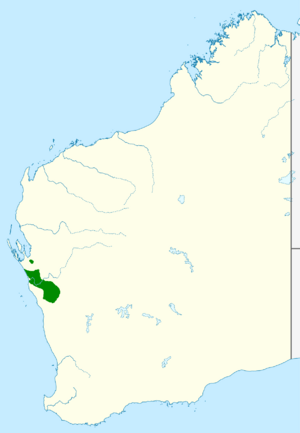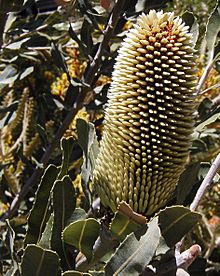Sceptre banksia facts for kids
Quick facts for kids Sceptre banksia |
|
|---|---|
 |
|
| Banksia sceptrum | |
| Scientific classification | |
| Kingdom: | |
| (unranked): | |
| (unranked): | |
| Order: | |
| Family: | |
| Genus: | |
| Subgenus: | |
| Section: | |
| Series: | |
| Species: |
B. sceptrum
|
| Binomial name | |
| Banksia sceptrum Meisn.
|
|
 |
|
| Range of Banksia sceptrum in green | |
| Synonyms | |
|
Sirmuellera sceptrum (Meisn.) Kuntze |
|
The Banksia sceptrum, also known as the sceptre banksia, is a special plant found in Western Australia. It grows near the central west coast, from Geraldton north to Kalbarri and Hamelin Pool. You can also find it further inland, almost reaching Mullewa.
This plant was first collected by an early settler named James Drummond. Later, in 1855, a Swiss botanist named Carl Meissner officially described it.
In nature, the sceptre banksia likes to grow in deep yellow or pale red sand. It's often found on sand dunes in tall shrubland areas. It can grow as a shrub up to 5 meters (16 feet) tall, but it's often smaller in windy places.
When there's a bushfire, this plant dies. However, it has a clever way to regrow: its woody seed pods open up in the heat of the fire, releasing seeds for new plants to grow. The sceptre banksia is famous for its bright yellow flowers. These tall, striking flower spikes, called inflorescences, stand out on the plant. It usually flowers in summer, mainly in December and January, but you might see flowers at other times too.
Contents
What the Sceptre Banksia Looks Like
The sceptre banksia usually grows as a shrub between 2 to 4 meters (6.5 to 13 feet) tall. Sometimes, it can even reach 5 meters (16 feet). It has many branches and can spread out to 4 meters (13 feet) wide. The main trunk is thick and has smooth or slightly cracked pale grey bark.
New branches grow in spring and autumn. They start with fine greenish-brown fur, but after about two years, they become smooth and pale grey.
The leaves are shaped like a rectangle with flat or slightly notched ends. They are about 4 to 9 centimeters (1.5 to 3.5 inches) long and 1 to 3 centimeters (0.4 to 1.2 inches) wide. They have short, blunt teeth along their edges. Both sides of the leaf are furry when new, but become smooth as they get older.
Amazing Yellow Flowers
The flower spikes are very tall and grow at the ends of the branches. They appear from November to January and are very eye-catching. It takes a long time for them to grow, about 6 to 7 months!
These bright yellow spikes are 7 to 21 centimeters (2.7 to 8.2 inches) tall and 8 to 10 centimeters (3 to 4 inches) wide. The flowers open slowly, taking 1 to 2 weeks to fully bloom from the bottom to the top of the spike. As the flowers get older, they turn grey.
Seeds and Seed Pods
After flowering, woody, oval-shaped seed pods, called follicles, develop on the old spikes. A group of these pods on an old spike is called an infructescence, and it can be 6 to 8 centimeters (2.3 to 3.1 inches) wide. Each spike can have up to 50 pods.
Each pod is about 1.5 to 2.5 centimeters (0.6 to 1 inch) long, 0.8 to 1.8 centimeters (0.3 to 0.7 inches) high, and 1 to 1.6 centimeters (0.4 to 0.6 inches) wide. When they are new, they are covered in dense grey fur.
The seeds inside are flattened and egg-shaped, about 3 to 3.5 centimeters (1.2 to 1.4 inches) long. They have a main part that holds the baby plant and a papery wing. One side of the seed is brown and a bit wrinkled, while the other side is shiny brown-black. A strong, dark brown seed separator keeps the seeds apart inside the pod.
When a sceptre banksia seed sprouts, its first pair of leaves, called cotyledons, are egg-shaped. They are about 1.4 to 1.5 centimeters (0.5 to 0.6 inches) long and 1.2 centimeters (0.5 inches) wide.
How Scientists Classify the Sceptre Banksia
The sceptre banksia was first described by Swiss botanist Carl Meissner in 1855. He used a plant sample collected by James Drummond near the Hutt River. The name sceptrum means "sceptre," which refers to the plant's tall, impressive flower spikes that look like a royal staff.
Over the years, different botanists have studied and classified Banksia plants. In 1870, George Bentham placed Banksia sceptrum in a group called Orthostylis. Later, in 1981, Australian botanist Alex George placed it in the subgenus Banksia, section Banksia, and series Banksia. This classification is still widely used today.
Here's how the sceptre banksia fits into the Banksia family, according to the Flora of Australia:
More recent studies using DNA have shown that Banksia sceptrum is very closely related to Banksia ashbyi.
Where the Sceptre Banksia Lives
The sceptre banksia grows in Western Australia. You can find it from Hamelin Pool in the north, south to about 60 kilometers (37 miles) east of Geraldton, and near Mullewa. It also grows east to Wandana Nature Reserve.
This area gets about 300 to 400 millimeters (12 to 16 inches) of rain each year. The plant prefers deep yellow or pale red sandy soils, often on sand dunes or flat areas. It grows in tall shrubland alongside other plants like B. ashbyi, mallee gums, sandplain cypress (Actinostrobus arenarius), and sandplain woody pear (Xylomelum angustifolium).
How the Sceptre Banksia Survives and Grows
Like many plants in southwest Australia, the sceptre banksia is good at living in places where bushfires happen often. Some Banksia species can survive fires by regrowing from their roots or thick bark. But the sceptre banksia is a "reseeder." This means the fire kills the plant, but it also helps the plant's seeds to be released from their tough pods. This way, new plants can grow and replace the old ones.
The seed pods on the old flower spikes stay closed until a fire burns them. After the fire, they open up and release the seeds. It takes about three to five years for new plants to grow big enough to flower again. If fires happen too often (less than four years apart), it can be a problem because the new plants won't have enough time to grow and produce seeds before the next fire. This could make it hard for the sceptre banksia to survive in those areas.
Unfortunately, the sceptre banksia is very sensitive to a plant disease called dieback. This disease is caused by a tiny water mould in the soil, and it can kill many Western Australian banksias.
Scientists have studied how climate change might affect this plant. They believe that the sceptre banksia's natural range might not shrink, and could even grow, if it can move into new areas that become suitable for it.
Growing Sceptre Banksia in Gardens
Banksia sceptrum is mainly grown for the cut flower industry. Its young flower spikes are often sold in flower shops across Australia because they are so beautiful.
Sometimes, people grow the sceptre banksia in gardens because its bright flower spikes are very striking. However, it needs a Mediterranean climate, which means dry summers. It also needs soil that drains water very well, as it is sensitive to the dieback disease.
If you want to grow it from seeds, you don't need to do anything special to them. They usually sprout in about 26 to 47 days. There is also a smaller, dwarf version of this plant that people sometimes grow.
See also
 In Spanish: Banksia sceptrum para niños
In Spanish: Banksia sceptrum para niños



